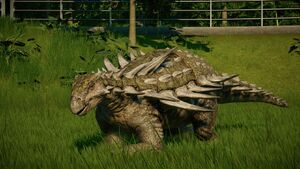Template:Era Template:Dinosaur Infobox
| When people come to the islands, they expect to see something dramatic, and this Polacanthus you’ve created delivers. |
Polacanthus is a genus of nodosaurid dinosaur that originated from Early Cretaceous Europe. A reclusive animal which doesn't tolerate more than six other dinosaurs in its enclosure, Polacanthus is first unlocked by the Hammond Foundation on Isla Pena.
Description
Polacanthus is a robust herbivore with a row of spikes running down its sides and tail and with an extra layer of spikes on its shoulders. It also has a thickened layer of bone with osteoderms across its hips. The base genome is grey coloured.
Behaviour
Polacanthus is a shy species that prefers to live alone or in pairs or in groups of three with only a few other species in the same enclosure. They can become stressed quite easily if the enclosure becomes overcrowded.
Palaeontology
Polacanthus was discovered on the Isle of Wight in 1865. Unfortunately, its remains have so far been rather scattered. Only its lower half and parts of its armour being well preserved. More complete remains of its closest relatives such as Gastonia and Gargoyleosaurus gave paleontologists some ideas on how Polacanthus must have looked like. The spikes on its osteoderms may have likely offered Polacanthus protection from predators that tried to attack it.
Polacanthus lived alongside many other species of dinosaurs in the Isle of Wight and the English county of Sussex, including more obscure nodosaurs such as Horshamosaurus and Hylaeosaurus. Other species include the fish-eating Baryonyx, the fierce predator Neovenator, as well as ornithopods Hypsilophodon and Iguanodon
File:Cosmeticres.png Cosmetics
Trivia
- Polacanthus was first confirmed on June 4th, 2018 in a brief still from a video.
- Polacanthus means "Many Spikes".
- The Tundra pattern for the Polacanthus somewhat resembles the skin pattern of the Gastonia in Jurassic Fight Club.
Gallery
Further reading
Template:JWEDinosaurs
External links
Polacanthus on Wikipedia






